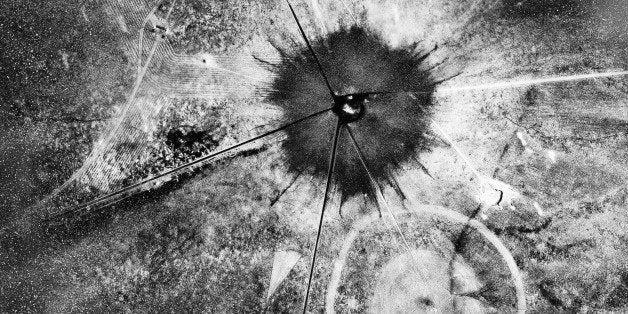
Co-authored by Ken Olum, research professor in the Physics and Astronomy Department, Tufts University.
A little over 70 years ago, our father, Paul Olum, stood with his colleagues in the desert near Alamogordo, New Mexico. They had spent the last two and a half years designing a new weapon, the first atomic bomb, and now they waited to see whether it would work. Then the explosion seemed to fill the sky, until it resolved into a huge mushroom-shaped cloud. The project had succeeded. They had designed and built the most powerful weapon ever seen on Earth.
Three weeks later, on August 6, 1945, the United States dropped an atomic bomb on Hiroshima, and, three days after that, another bomb on Nagasaki. The two bombs together killed over 100,000 people instantly, and a similar number died later from radiation exposure. Paul had mixed feelings about the bombing of Hiroshima. It seemed clear it would end the war swiftly, but there had been a very high cost in civilian lives. However, he felt the bombing of Nagasaki was unconscionable, because three days had not been long enough for the surrender.
Six days after the bombing of Nagasaki, Japan did announce its surrender. World War II was over, but the nuclear arms race had begun, and Paul Olum became a lifelong advocate of nuclear arms control and disarmament.
By the 1980s, the United States and the Soviet Union together had amassed about 27,000 "active" strategic nuclear bombs each hugely more powerful than those that destroyed Hiroshima and Nagasaki. The arsenals of either nation were sufficient to destroy humanity many times over.
Paul had been only 24 years old when he and our mother Vivian went to Los Alamos in 1943. After the war was over, he went on to a distinguished career as a mathematics professor at Cornell and later as provost and then president of the University of Oregon. Yet, whatever else he was doing, he felt a responsibility to talk about the dangers of nuclear weapons and the importance of disarmament.
In 1983, Paul and Vivian received an invitation to a celebration of the 40th anniversary of the opening of the Los Alamos National Laboratory, where the atomic bombs had been designed. They felt they did not want to celebrate the building of those bombs, which led to nuclear arsenals that could destroy the human race. Paul drafted a petition calling for an end to the nuclear arms race and the eventual elimination of nuclear weapons. It was signed by 70 scientists, including five Nobel Prize winners, and widely publicized. The scientists wrote that they were "profoundly frightened for the future of humanity."
Paul's efforts, and those of many others, brought a turning point in the arms race. Treaties between the United States and the Soviet Union and later Russia began to reduce the numbers of warheads and remove them from active status. When Paul died in 2001, the total number of active strategic nuclear warheads had been reduced to about 14,000. When the New START treaty of 2011 is fully implemented, the U.S. and Russia will have about 3,000 deployed strategic warheads in total, but this is still more than enough to destroy civilization.
Unfortunately, the threat of nuclear weapons seems to have faded from public consciousness, perhaps having been displaced by concerns over climate change. Climate change is a very serious threat, but it is a threat of a different character. Climate change could kill billions of people over the course of decades and render parts of the world uninhabitable. Nuclear war could kill billions of people immediately and might render the entire world uninhabitable as a result of radioactive fallout and nuclear winter (severe global cooling caused by soot propelled into the stratosphere from burning cities.)
So it is crucial that nuclear disarmament continue. Instead, the U.S. and Russia seem poised on the brink of a new nuclear arms race. Present U.S. plans involve new warheads with new missiles, bombers, and submarines to deliver them, at a total cost of about $1 trillion over the next 30 years. And this huge expense does not make America safer. Our current arsenal goes far beyond anything needed as a deterrent. Instead, it increases the risk that these weapons will someday be used, either intentionally, accidentally, or because they fall into the wrong hands.
Enough is enough. More than 30 years after Paul's Los Alamos disarmament petition, nuclear weapons still pose a threat to the existence of the human race. The time has come to end this threat, so that that 30 years from now it will not be necessary for our children to begin an article, "One hundred years ago our grandfather stood in the desert near Alamogordo...."
Joyce Olum Galaski is rabbi emeritus of Congregation Ahavas Achim in Westfield, Massachusetts, and Ken Olum is a research professor in the Physics and Astronomy Department at Tufts University. This year, they established the Paul Olum Grant Fund through Ploughshares Fund to support scientists working for nuclear disarmament.